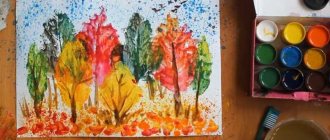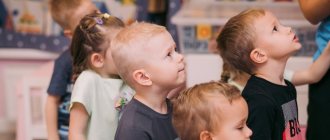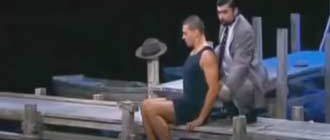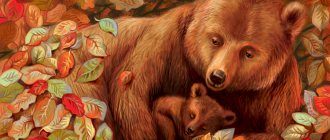FCCM preparatory group
Long-term plan for FCCM for children of the preparatory group
| September | 2 week | Subject: | Getting to know the natural environment "Rules of conduct in the forest" | Environmental education of preschool children in Crimea. Page 24. |
| Target: | To form an idea of the Crimean forest as a home of animals and plants that are in close connection with each other. Clarify knowledge about the rules of behavior in the forest. | |||
| 3 week | Subject: | Familiarization with the subject and social environment "To Grandfather's Farm" | Dybina O.V. Familiarization with the subject and social environment. No. 18, Page 56 | |
| Target: | Introduce children to a new profession - farmer. Give an idea of the labor actions and results of a farmer’s labor. To bring to an understanding of the holistic appearance of a person - a worker on a farm: hard work, love for all living things, caring for people. Foster a sense of appreciation and respect for agricultural workers. | |||
| 4 week | Subject: | Getting to know the natural environment "Forest-steppe: location and climate" | Shorygina, T.A. Conversations about the steppe and forest-steppe. Page 4 | |
| Target: | Introduce the concept of “forest-steppe”, explain where it is located, what territory it occupies, what the climate is in this natural zone. Talk about the gradual transition of the forest to the steppe. train in memorizing poems, guessing riddles. Teach complete answers to questions, develop the ability to think logically. Promote the development of interest in the world around us. | |||
| 5 week | Subject: | Familiarization with the subject and social environment "Steppes: climate location" | Shorygina, T.A. Conversations about the steppe and forest-steppe. Page 7 | |
| Target: | Form an idea of the location and climate of the steppes. Introduce concepts such as “drought”, “dry wind”, “forest shelterbelts”. Talk about the soil in the steppes and the cultivated plants that farmers and gardeners grow in the steppe zone. Learn to solve riddles, play words, answer questions. | |||
| October | 1 Week | Subject: | Getting to know the natural environment « Journey to the Crimean forest" | Environmental education of preschool children in Crimea. Page thirty. |
| Target: | Continue to enrich and clarify children's knowledge about plants, trees, herbs, mushrooms, and flowers. Strengthen knowledge about medicinal herbs and the ability to read a map. Introduce the Red Book. | |||
| 2 week | Subject: | Getting to know the natural environment "What is planet Earth" | Kolomiychenko, L.V. Classes for children 6-7 years old on social and communicative development. No. 31, Page 218 | |
| Target: | Formation of a tolerant attitude towards one’s own ethnic culture and the culture of other peoples. Tasks: enrich initial ideas about planet Earth, the people who inhabit it, and their equality; stimulate the manifestation of cognitive interest in the phenomena of planet Earth, develop the skills of independent application of acquired knowledge in gaming activities. | |||
| 3 a week | Subject: | Familiarization with the subject and social environment "World Holidays" | Kolomiychenko, L.V. Classes for children 6-7 years old on social and communicative development. No. 32, Page 225 | |
| Target: | Formation of a conscious, socially valuable attitude towards world holidays. Tasks: enrich initial ideas about planet Earth, about the common holidays of the people who inhabit it, the events for which countries have become famous throughout the world; stimulate cognitive interest in the phenomena of planet Earth; to develop skills in the practical application of information and gaming activities. | |||
| 4 week | Subject: | Familiarization with the subject and social environment "State symbols" | Kolomiychenko, L.V. Classes for children 6-7 years old on social and communicative development. No. 29, Page 206 | |
| Target: | Forming a respectful attitude towards state symbols. Tasks: enrich initial ideas about the symbolism of Russia; stimulate the manifestation of cognitive interest in the phenomena of history and culture of their country; to form skills of behavior adequate to knowledge about symbolism, independent application of acquired knowledge in gaming activities. | |||
| November | 1 Week | Subject: | Familiarization with the subject and social environment "Space" | Dybina O.V. Familiarization with the subject and social environment. No. 16, Page 53 |
| Target: | Expand children's understanding of space; bring to the understanding that space exploration is the key to solving many problems on Earth; tell children about Yuri Gagarin and other space heroes. | |||
| 2 week | Subject: | Familiarization with the subject and social environment "Residents of Russia" | Kolomiychenko, L.V. Classes for children 6-7 years old on social and communicative development. No. 30, Page 212 | |
| Target: | Formation of a tolerant attitude towards one’s own national culture and the culture of other peoples. Tasks: enrich initial ideas about people of different nationalities inhabiting Russia, their equality; stimulate the manifestation of cognitive interest in the phenomena of history and culture of their country; to develop skills for independent application of acquired knowledge in gaming activities. | |||
| 3 a week | Subject: | Familiarization with the subject and social environment “It’s so nice in our garden” | Dybina O.V. Familiarization with the subject and social environment. No. 4, Page 33 | |
| Target: | Expand and generalize children’s ideas about the social significance of the kindergarten, about its employees, about the rights and responsibilities of children attending kindergarten. Cultivate a friendly attitude towards peers and others. | |||
| 4 week | Subject: | Getting to know the natural environment “What kind of forests are there? Spruce and pine forests" | Shorygina, T. A. Conversations about the Russian forest. Page 18 | |
| Target: | To form in children an idea of what forests are like. Teach children to name the inhabitants of the forest and plants. Develop cognitive interest. Cultivate a love for nature. | |||
| 5 week | Subject: | Getting to know the natural environment How is the forest structured? | Shorygina, T. A. Conversations about the Russian forest. Page 12 | |
| Target: | Introduce natural areas: forest, meadow, taiga. Expand knowledge about forest plants. Consolidate knowledge about the “floors” of the forest; the ability to recognize birds by their voices and appearance. Develop the ability to behave correctly in nature so as not to harm it. Continue to introduce the Red Book, which lists rare and endangered animals and plants of our native land. | |||
| December | 2 week | Subject: | Getting to know the natural environment How animals prepare for winter | Summary from work experience. |
| Target: | Expand your understanding of wild animals. Tell: -why do animals molt? -Why some of them migrate to more convenient places; -how people help animals by feeding them. Expand knowledge about how animals prepare for winter. | |||
| 3 week | Subject: | Familiarization with the subject and social environment "Traditions of the Russian family" | Kolomiychenko, L.V. Classes for children 6-7 years old on social and communicative development. No. 38, Page 261 | |
| Target: | Formation of a respectful attitude towards cultural values, customs and traditions of family relationships of Russian people. Tasks: enrich initial understanding of the specifics of relationships, family ties, norms, customs and traditions in the Russian family; cultivate cognitive interest in the culture of one’s people; to form methods of independent application of knowledge in gaming and speech activities. | |||
| 4 a week | Subject: | Getting to know the natural environment “Where did the Christmas tree come from to visit?” | Summary from work experience. | |
| Target: | Introduce the ancient Russian holidays: Christmas and Christmastide, explain their origin and purpose. Tell: about the custom of decorating the Christmas tree, where it came from; about the traditions of celebrating the New Year among different nations. Nurture love to the history of Russia, national pride, a sense of belonging to one’s people Introduce various liquids, identify differences in the freezing processes of various liquids. | |||
| 5 week | Subject: | Familiarization with the subject and social environment "Christmas" | Malova, V.V. No. 18, Page 198 | |
| Target: | Talk about the holiday of the Nativity of Christ, about the customs of celebrating Christmas in the Russian village. Introduction to the nativity scene. Christmas performance. | |||
| January | 1 Week | Holidays | ||
| 2 week | Subject: | Familiarization with the subject and social environment "Wintering birds of our city" | Summary from work experience. | |
| Target: | Introduce wintering birds. Study their features. Cultivate a love for nature. Develop an interest in bird watching. Dictionary: wintering, migratory birds, feeder | |||
| 3 week | Subject: | Getting to know the natural environment “What do we call north?” | Shorygina, T.A. Conversations about the Russian North. Page 5 | |
| Target: | Introduce the concept of “North”; explain what natural areas make up the northern part of Russia. To consolidate knowledge of the characteristic signs of winter, compare them with the nature of the northern regions. Train in memorizing poems, guessing riddles. Learn to answer the teacher’s questions with reason, develop the ability to compare and think logically, enrich speech and vocabulary. Promote the development of interest in the world around us. | |||
| 4 a week | Subject: | Getting to know the natural environment “What animals live in the Arctic?” | Shorygina, T. A. Conversations about the Russian North. Page 32 | |
| Target: | Form an idea of the inhabitants of the Arctic: polar bear, seal, walrus. Talk about their habits, how these animals adapted to the conditions of the Far North. Learn to compare (for example, the lifestyle and appearance of polar bears), give complete answers to questions. Learn to solve riddles and explain riddles and explain. what words helped to find the answer. | |||
| February | 1 Week | Subject: | Familiarization with the subject and social environment "About Love and Friendship" | Kolomiychenko, L.V. Classes for children 6-7 years old on social and communicative development. No. 6, Page 73 |
| Target: | Formation of friendly, respectful relationships between peers of the same and opposite sex. Objectives: to enrich generalized ideas about the need and significance of showing friendly, respectful relationships between children of different sexes, understanding between them; promote interest in the sphere of relationships between peers of the same and opposite sex; promote independent application of acquired knowledge in gaming activities. | |||
| 2 week | Subject: | Familiarization with the subject and social environment “Generalissimo A.V. Suvorov" | Kolobanova, A. I. Project "Heroes of the days of military glory" Page 25 | |
| Target: | Introduce children to the great Russian commander A.I. Suvorov; help children realize the main thing: in order to become a master of their craft (in this case, a military commander), you need to work hard on yourself; to instill in children respect for the Russian warrior, courage, kindness, discipline, and devotion to the Motherland. | |||
| 3 week | Subject: | Familiarization with the subject and social environment "Defenders of the Motherland" | Dybina O.V. Familiarization with the subject and social environment. No. 12, Page 46 | |
| Target: | Expand children's knowledge about the Russian army; cultivate respect for the defenders of the Fatherland, for the memory of fallen soldiers (lay flowers at obelisks and monuments); to develop the ability to talk about the military service of fathers, grandfathers, brothers, to cultivate the desire to be like them. | |||
| 4 a week | Subject: | Familiarization with the subject and social environment "Friendly family" | Dybina O.V. Familiarization with the subject and social environment. No. 2, Page 29 | |
| Target: | Summarize and systematize children’s ideas about family (people who live together, love each other, take care of each other). Expand ideas about the ancestral roots of the family; intensify cognitive interest in family and loved ones; cultivate a desire to take care of loved ones, develop a sense of pride in your family. | |||
| 5 week | Subject: | Familiarization with the subject and social environment "Connoisseurs" | Dybina O.V. Familiarization with the subject and social environment. No. 13, Page 47 | |
| Target: | Strengthen children's understanding of the richness of the man-made world; expand knowledge about subjects that satisfy the aesthetic and intellectual needs of a person; develop interest in understanding the world around us. | |||
| March | 2 week | Subject: | Familiarization with the subject and social environment "Dymkovo toy". | Summary from work experience. |
| Target: | Introduce the history of the Dymkovo toy. To develop knowledge about the features of painting toys, color, and basic elements of the pattern. Continue to educate on folk traditions. To instill love and respect for the work of folk craftsmen. Develop an interest in studying folk crafts. Introduce children to wood crafts, where they are used, as workers who process wood are called. | |||
| 3 week | Subject: | Familiarization with the subject and social environment "Blue-blue Gzhel." | Summary from work experience. | |
| Target: | Continue your acquaintance with Russian folk crafts. Introduce Gzhel and Skopino ceramics. Learn to identify their similarities and differences. To form an idea of clay as the basis of pottery production; Continue to introduce the properties of clay (hard when dry, plastic and soft when wet); Enrich children’s ideas about the use of clay by humans; Promote the development of creative potential through playful improvisation. Develop the ability to hear an adult, teach the basics of mutual assistance. | |||
| 4 a week | Subject: | Getting to know the natural environment Decorative and applied art of Crimea". | Summary from work experience. | |
| Target: | Continue to cultivate interest in the decorative and applied arts of Crimea and the desire to study them. To introduce the diversity and features of the decorative and applied arts of Crimea. Foster a sense of patriotism. Learn to recognize different types of fabrics, compare their qualities and properties; understand that the properties of a material determine its use. | |||
| 5 a week | Subject: | Getting to know the natural environment "Excursion to the Museum." | Summary from work experience | |
| Target: | Introduce the concept of “museum” and its purpose. Give an idea of the profession of people who work in the museum. Introduce the interior design and purpose of the museum premises. Foster activity and curiosity. Has an idea of leather as a material from which a person makes various things. | |||
| April | 1 Week | Subject: | Getting to know the natural environment “The earth loves care” | Malova, V.V. No. 30, Page 218 |
| Target: | To cultivate love for one’s native land, to evoke a desire to protect the land, to take care of it and its inhabitants. Acquaintance with the Russian round dance, proverbs about Mother Earth, and the fairy tale “The Language of the Bird.” | |||
| 2 week | Subject: | Getting to know the natural environment "Plant Kingdom: Herbs" | Summary from work experience | |
| Target: | To consolidate knowledge about herbs and flowers as representatives of the flora of the Earth, their beauty and benefits. Summarize the knowledge that on our planet there is a huge kingdom of plants: trees, shrubs, herbaceous plants. Tell: -about the variety of herbs and their benefits; -a variety of flowers - wild, garden, forest, field, meadow, marsh. | |||
| 3 a week | Subject: | Familiarization with the subject and social environment "My Fatherland Russia" | Dybina O.V. Familiarization with the subject and social environment. No. 14, Page 49 | |
| Target: | To develop children’s interest in learning about Russia; cultivate a sense of belonging to a certain culture, respect for the cultures of other peoples; the ability to talk about the history and culture of one’s people. | |||
| 4 week | Subject: | Familiarization with the subject and social environment "Sights of our city" | Kolomiychenko, L.V. Classes for children 6-7 years old on social and communicative development. No. 25, Page 185 | |
| Target: | Fostering a sense of love for your hometown. Tasks: systematize children’s knowledge about the sights, about the streets of their city, about people of different nationalities living in their hometown, the nature of their native land; evoke positive emotions in the process of familiarization with local history material; teach methods of practical application of knowledge in gaming and speech activities. | |||
| May | 1 Week | Subject: | Familiarization with the subject and social environment “There are no shortage of heroes in Rus'” | Malova, V.V. No. 33, Page 222 |
| Target: | Talk about the victory of our people in the Great Patriotic War, about Georgy Zhukov. Remember famous commanders. Acquaintance with “The Tale of Five Sons - Young Falcons” by E. Blaginina, with the song of the Great Patriotic War, with paintings by Russian artists on a military theme. | |||
| 2 week | Subject: | Familiarization with the subject and social environment "School" | Dybina O.V. Familiarization with the subject and social environment. No. 6, Page 36 | |
| Target: | Introduce children to the teaching profession and to school. Show the social significance of the work of a school teacher (gives knowledge of the Russian language, mathematics and many other subjects, educates). To introduce the business and personal qualities of a teacher (smart, kind, fair, attentive, loves children, knows a lot and passes on his knowledge to students). Foster a sense of gratitude and respect for the teacher’s work; develop interest in school. | |||
| 3 a week | Subject: | Familiarization with the subject and social environment "Human rights" | Kolomiychenko, L.V. Classes for children 6-7 years old on social and communicative development. No. 21, Page 165 | |
| Target: | Forming the foundations of a conscious and respectful attitude towards the personal rights and dignity of other people. Tasks: to specify ideas about human rights; expand children's understanding of international human rights instruments; develop self-esteem; promote the development of skills for independent application of acquired knowledge in gaming activities. | |||
| 4 week | Subject: | Getting to know the natural environment "Nature and Health" | Summary from work experience. | |
| Target: | To bring to an understanding that the environment influences the human condition. Continue to introduce the basics of a healthy lifestyle. Cultivate a desire to lead a healthy lifestyle. Learn: -see the emotional and physical state of adults and children; -understand the state of plants and animals near humans; - show appropriate attitude in each specific case | |||
| 5 week | Subject: | Getting to know the natural environment "Hello, red summer" | Summary from work experience. | |
| Target: | Fix the name of the summer months, name them sequentially. Continue to introduce folk signs. Bring to the understanding that to improve health in the summer you can swim, walk barefoot, and bask in the sun. Learn to reflect the impressions received from communicating with nature in stories, drawings, and games. Introduce the summer solstice - June 22 |
Literature:
1. Dybina, O.V. Familiarization with the subject and social environment Preparatory group for school. –M.: MOSAIC-SYNTHESIS, 2015.-Page. 80
2. Shorygina, T.A. Conversations about the Russian North. Methodological recommendations.-M.: TC Sfera, 2010.- P.96
3. Kolomiychenko, L.V., Chugueva, G.I., Yugova, L.I. On the way to goodness. Classes for children 6-7 years old on social and communicative development and social education / L.V. Kolomiychenko. – M.: TC Sfera, 2015. – P.320
4. Malova, V.V. Lesson notes on spiritual and moral education of preschool children / V.V. Malova. – M.: Vlados, 2010
5. Kolobanova, A.I. Project “Hero of the Days of Military Glory”. Senior preschool age – Volgograd: Teacher, 2013.- P. 63
6. Environmental education of preschool children in Crimea / Textbook. - Simferopol: Crimean State Educational and Pedagogical Publishing House, 1995.-P. 65
7. Shorygina, T. A. Conversations about the steppe and forest-steppe. Guidelines. -M.: TC Sfera, 2009.- P. 64
8. Shorygina, T. A. Conversations about the Russian forest. Guidelines. -M.: TC Sfera, 2010.- P. 96
Autumn is outside
Summary of educational activities to familiarize yourself with the surrounding world in a preparatory group for school
Target:
formation of ideas about the autumn season.
Tasks:
- consolidate ideas about the seasons and their sequence;
- expand knowledge about autumn changes in nature;
- repeat the concepts of “sound”, “word”;
- introduce new words and expressions, properties and qualities of phenomena and objects into children’s active vocabulary;
- motivate children to freely conduct an active dialogue, actively speak out, justifying their opinions;
- learn to compose short descriptive stories, including using a diagram;
- develop logical thinking and coherent speech, creative imagination, auditory and visual attention;
- cultivate interest in native nature and its knowledge.
Preliminary work:
reading and discussing children's literature on the theme “Autumn”; observation of leaf fall and autumn changes in the nature of the city, on the territory of the kindergarten. Conducting didactic games “Guess which tree”, “Leaf fall”, “What came first”. Printing with autumn leaves, appliqués, modeling “Mushroom basket”. Listening to the music of P. Tchaikovsky “The Seasons” “Autumn”.
Materials:
illustrations “Seasons”, K. Ushinsky’s book “Four Wishes”, autumn leaves (from birch, oak, maple), pictures depicting these trees, a basket of vegetables and fruits, ears of wheat, rye, a diagram for compiling a descriptive story , several plot pictures and landscape paintings on the theme “Autumn”.
Equipment for the experiment according to the number of children:
flat dishes with dry soil, a strip of dark-colored sandpaper in the form of a path, trays, napkins, small watering cans with water.
Progress of the lesson
Educator :
Hello, guys.
Look at the book in my hands. What is the name of this story by K. Ushinsky? Why did the author call it not three, not five, not six, but four wishes? ( The teacher praises the children for correct, reasoned answers.
)
Educator:
I offer you the game “What is earlier, what is later?”
Please answer my questions. What happened before autumn? And later? What happened before summer? And before spring? And later in winter? ( Children answer and sit on chairs standing nearby in a semicircle facing the floor board.
)
Educator:
You did great.
Now a new game is “Find the Bug”. ( The teacher invites several children to place illustrations of 4 plot paintings “Seasons” on the board in the correct sequence and name them in order.
)
Educator:
How many months are there in a year?
How many autumn months are there? Name them. ( Children's answers
.)
Educator:
What vowel sounds do you know?
[A], [O], [I], [Y], [U], [E] and [IA], [IYU], [IE], [YO]. Let's sing them. Why are these sounds called vowels? What seasons begin with the vowel sound [O]? Now name the words that begin with the sound [O], and I will write them down. ( The teacher writes down the words the children call in a column. Then the children select definition words for these words.
)
Educator:
Guys, let's try to play with words. Let's substitute the same definition words for the word “Autumn”. What did we get?
Children:
Autumn is damp, beautiful, boring, soft, gloomy, cheerful, fearful.
Educator:
Can you say that about autumn or not?
Why? ( Children think, express their opinions, argue, prove. The teacher summarizes the children’s statements.
)
Educator:
And now we will conduct an autumn physical education session.
( The teacher scatters leaves of different colors and shapes (maple, oak, birch) all over the carpet.
) What is the name of this autumn natural phenomenon?
( Leaf fall
.) From what words was this word formed?
( Leaves + are falling.
) Let's collect leaves, but not all in a row, but of our choice only from one tree.
You can admire them, rustle, dance, run. ( Pictures of oak, birch, maple are hung on the board.
)
Educator:
Now find your tree!
( Children find their tree, run up to it, identify it, compare it by leaves.
)
Educator:
Children, close your eyes and imagine autumn in the form of a person.
( The music of P.I. Tchaikovsky “The Seasons” sounds. The children close their eyes, and the teacher speaks quietly.
) Each of you has your own autumn... Who do you imagine autumn to be?
And you? Describer her. ( 3-4 children answer. Children name and describe imaginary images of autumn. The teacher summarizes the children’s answers.
)
Educator:
Now for a moment of questions.
Why can you see fewer people wearing high rubber boots in the city in the fall than in the countryside? Where do we live in a city or village? What is the name of the asphalt path that people walk on? ( The teacher suggests going to the tables and removing the napkins from the trays.
)
Educator:
Let's move on to experiments.
What does the dark stripe look like? ( Pavement
.) Where are there more asphalt roads and sidewalks?
Walk your toes along the sidewalk. What is he like? ( Dry, rough, clean.
) Now walk on the ground, compare the sensations.
What do you think the weather was like here? ( Sunny, dry.
) Let's make it rain!
( Children use a small watering can to water the experimental surface.
) Walk along the sidewalk.
What are your fingers like now? ( Wet, damp, moist, clean.
) Walk along the ground in the village.
What happened to your fingers? ( They got dirty. Children speak out and come to an answer to the question posed.
)
Children:
It is dirtier in the village in autumn, so people wear rubber boots.
Educator:
So they say about rainy weather: “slush, damp.”
( Children repeat new words.
)
Educator:
If you were fashion designers, what color fabric would you choose for your fall outfit?
( Children's answers.
) Let's look at paintings on the theme “Autumn.”
( While the children are looking, the teacher hangs a plan diagram on the board for compiling a descriptive story “Autumn.”
)
Educator:
And now we will summarize everything we saw and new into a story about autumn.
( Two forms of work: collective and individual
).
Educator:
Well done! I liked your stories about autumn.
Lyudmila Nagornova, teacher, MADOU D/s No. 7 , Salavat, Bashkortostan





